
Praxiteles of Athens, the son of Cephisodotus the Elder, was the most renowned of the Attic sculptors of the 4th century BC. He was the first to sculpt the nude female form in a life-size statue. While no indubitably attributable sculpture by Praxiteles is extant, numerous copies of his works have survived; several authors, including Pliny the Elder, wrote of his works; and coins engraved with silhouettes of his various famous statuary types from the period still exist.

The Farnese Hercules is an ancient statue of Hercules made in the early third century AD and signed by Glykon, who is otherwise unknown; he was an Athenian but he may have worked in Rome. Like many other Ancient Roman sculptures it is a copy or version of a much older Greek original that was well known, in this case a bronze by Lysippos that would have been made in the fourth century BC. This original survived for over 1500 years until it was melted down by Crusaders in 1205 during the Sack of Constantinople. The enlarged copy was made for the Baths of Caracalla in Rome, where the statue was recovered in 1546, and is now in the Museo Archeologico Nazionale in Naples. The heroically-scaled Hercules is one of the most famous sculptures of antiquity, and has fixed the image of the mythic hero in the European imagination.
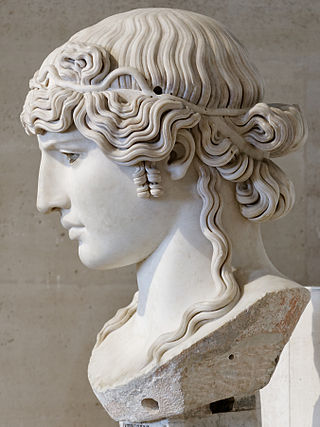
The Antinous Mondragone is a 0.95-metre high marble example of the Mondragone type of the deified Antinous. This colossal head was made sometime in the period between 130 AD to 138 AD and then is believed to have been rediscovered in the early 18th century, near the ruined Roman city, Tusculum. After its rediscovery, it was housed at the Villa Mondragone as a part of the Borghese collection, and in 1807, it was sold to Napoleon Bonaparte; it is now housed in the Louvre in Paris, France.

A sculptural pairing of the tyrannicides Harmodius and Aristogeiton was well known in the ancient world in two major versions but survives only in Roman marble copies. The lovers Harmodius and Aristogeiton were Athenian heroes whose act of daring in 514 BC opened the way for Athenian democracy.

The Hermes of the Museo Pio-Clementino is an ancient Roman sculpture, part of the Vatican collections, Rome. It was long admired as the Belvedere Antinous, named from its prominent placement in the Cortile del Belvedere. It is now inventory number 907 in the Museo Pio-Clementino.

The sculptures of Hermes Fastening his Sandal, which exist in several versions, are all Roman marble copies of a lost Greek bronze original in the manner of Lysippos, dating to the fourth century BCE. A pair of sandals figures in the myth of Theseus, and when the painter-dealer Gavin Hamilton uncovered an example in the swamp ground called the Pantanello at Hadrian's Villa at Tivoli in 1769, he hesitated between calling it a Theseus or a Cincinnatus. Jason's myth also involves a lost sandal. When Augustus Hare saw that sculpture in the Ball Room of Lansdowne House, in Berkeley Square, he noted it as "Jason fastening his sandal."
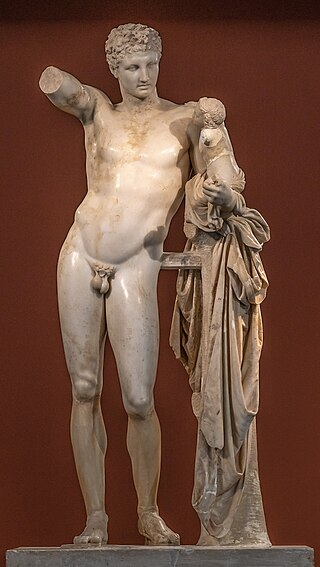
Hermes and the Infant Dionysus, also known as the Hermes of Praxiteles or the Hermes of Olympia is an ancient Greek sculpture of Hermes and the infant Dionysus discovered in 1877 in the ruins of the Temple of Hera, Olympia, in Greece. It is displayed at the Archaeological Museum of Olympia.

The Funerary naiskos of Aristonautes is a funerary monument dating to around 320 BC, on display in the National Archaeological Museum of Athens (NAMA) with the inventory number 738.
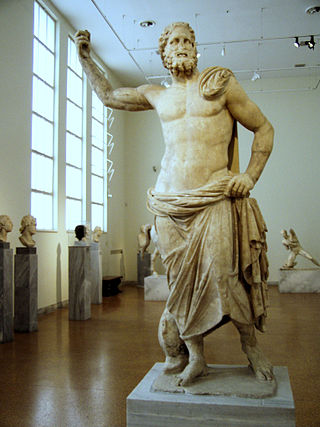
The Poseidon of Melos is a statue of Poseidon in the National Archaeological Museum, Athens (NAMA), with an inventory number 235, which is dated to the last quarter of the second century BC, thus to the Hellenistic Period.

The Great Eleusinian Relief is a large marble relief kept in the National Archaeological Museum, Athens in Greece. It depicts a scene of the Eleusinian Mysteries with the principal deities, Demeter, Persephone and the hero Triptolemus. The large relief was unearthed in the town of Eleusis, which was an important center for the worship of Demeter and Persephone, in 1859.

The Atalante Hermes or Hermes of Atalante is a marble funerary statue of a youth depicted as Hermes, the god of messengers and psychopomp of the dead. It was excavated in the town of Atalante in Phthiotis, in Greece. It is now kept in the Archaeological Museum of Athens with accession number 240.
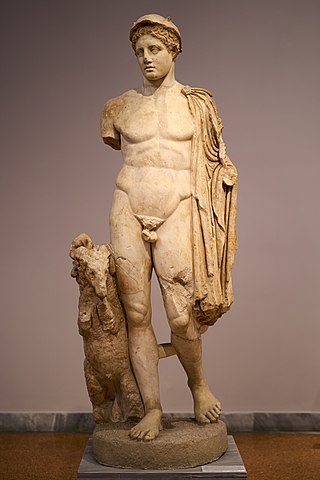
Hermes Criophorus is a marble sculpture of the second century AD depicting the Greek god Hermes, as god of pasture and shepherds, carrying away a young ram. The sculpture is a Roman copy of a Greek original of the fifth century BC. It was discovered in Troezenia in southern Greece in late nineteenth century, and it is now part of the collection of the National Archaeological Museum in Athens.

Hermes of Aegium is a lifesize Roman sculpture of the Greek messenger god Hermes found in the town of Aegium in southern Greece in mid nineteenth century. It is now housed in the National Archaeological Museum in the capital Athens under accession number 241. It is nearly intact with minor damage.

The Apollo Omphalos is an ancient Roman marble copy of a Greek original bronze sculpture in typical early Archaic period style, depicting Apollo, the Greek god of music, medicine, and prophecy. Today it is housed in the National Archaeological Museum of Athens, in Greece. The sculpture was found in several fragments which were put together, and bears several signs of damage.
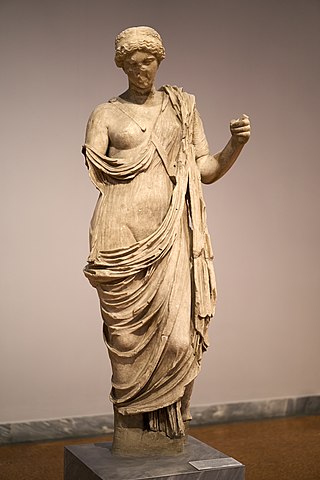
Armed Aphrodite is a first-century AD Roman marble sculpture depicting Aphrodite Areia, or the war-like aspect of the Greek goddess Aphrodite, who was more commonly worshipped as a goddess of beauty and love. It is modelled after a lost Greek original of the fourth century BC made by Polykleitos the Younger, and is now kept in the National Archaeological Museum of Athens in Greece with accession number 262.

The Group of Aphrodite, Pan and Eros is an ancient marble Greek sculpture of the first century BC depicting the goat-legged god Pan trying to woo Aphrodite, the goddess of love and desire, unsuccessfully. It was found on the Aegean island of Delos in the early twentieth century, and is now housed in the National Archaeological Museum of Athens with inventory number 3335.

The Hermes of Messene is a large ancient Roman statue of the god Hermes, the Greek god of trade, commerce and messenger of the gods. It was found in 1996 in the old gymnasium of Ancient Messene, in southwestern Peloponnese, Greece, and now exhibited in the Archaeological Museum of Messene in the ancient site of Messene.

The Nike of Epidaurus is an ancient Greek marble statuette of Nike, the Greek goddess of victory, by the sculptor Timotheos, a renowned sculptor of antiquity. The Nike was once part of the west pediment of the temple of Asclepius, the Greek god of medicine and healing, in ancient Epidaurus. It is now kept in the National Archaeological Museum of Athens with inventory number 155 in Room 22.
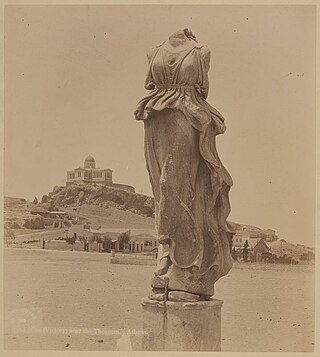
The Nike of Megara is a large ancient Greek marble sculpture of the late fourth or early third century BC. The Hellenistic statue depicts Nike, the winged Greek goddess of victory; its arms, wings and head are not preserved. The statue was discovered in the nineteenth century near Megara, a town near Athens, Greece. It is kept in the National Archaeological Museum of Athens, although in storage, and not in exhibition.

The Statuette of Mercury is a Roman bronze statuette of the god Hermes created in the 2nd century CE. Acquired by the Metropolitan Museum of Art in 2023, it is among a set of similar set of figurines acquired throughout the museum's history to be of either Gallic or Italic origin that likely served as a figure of worship in family household shrines.





















